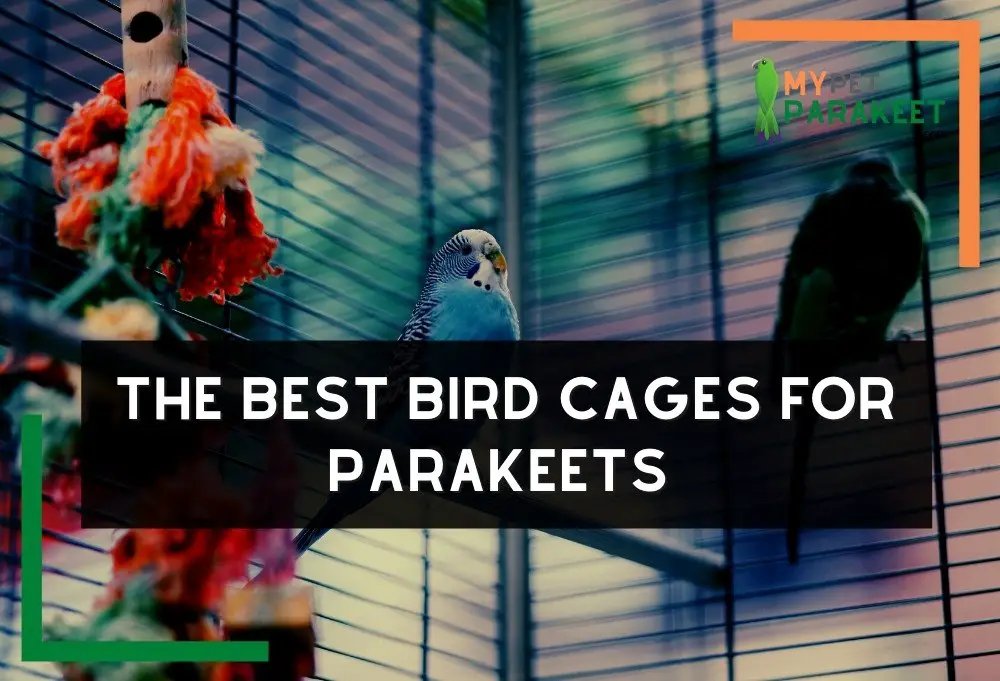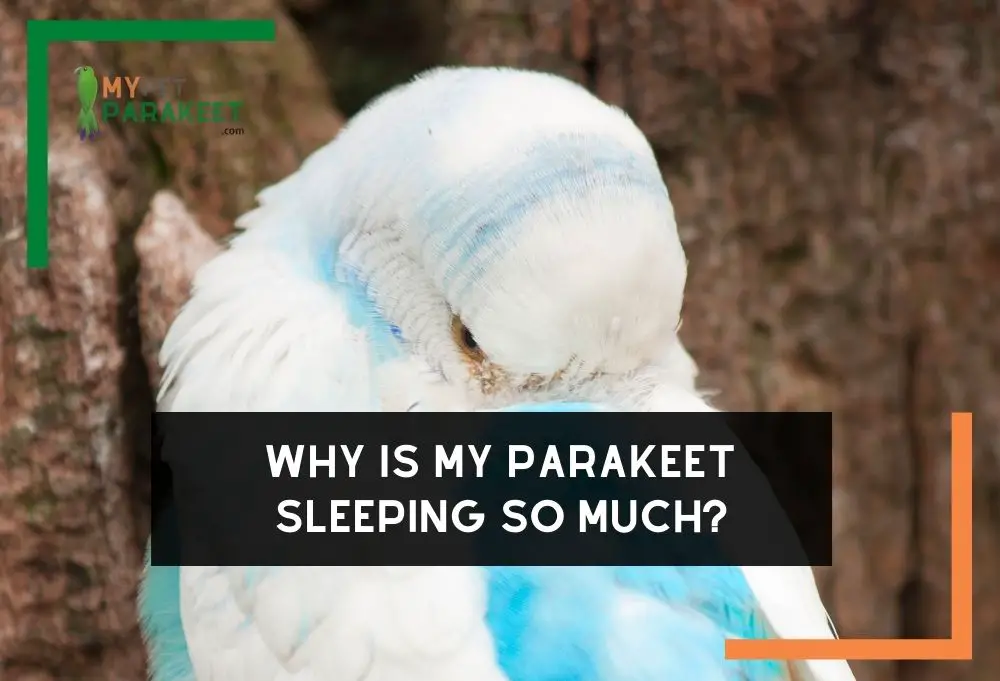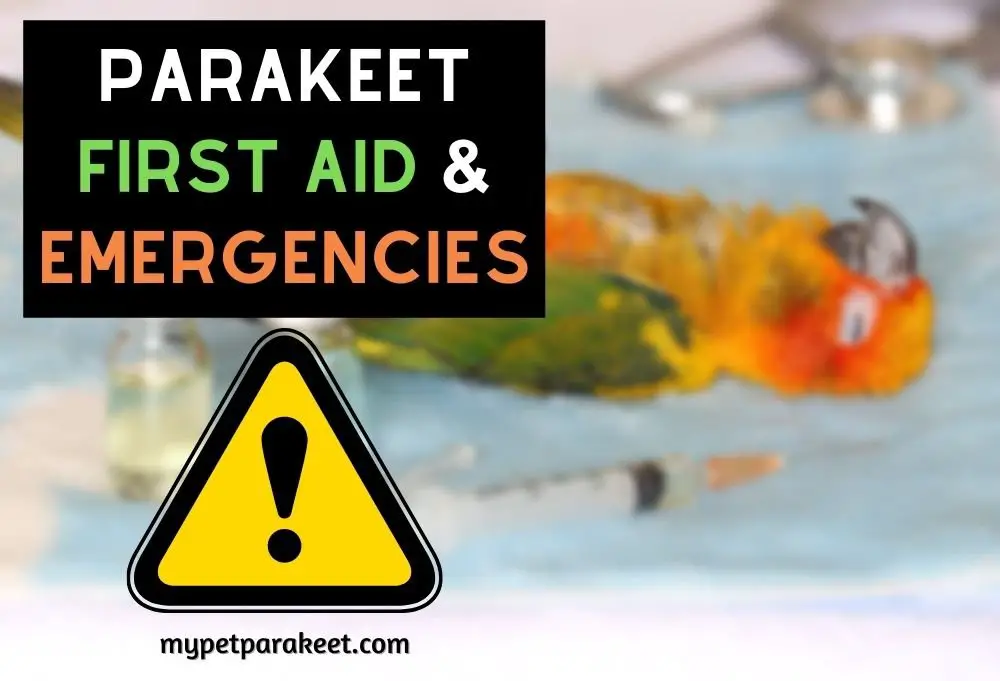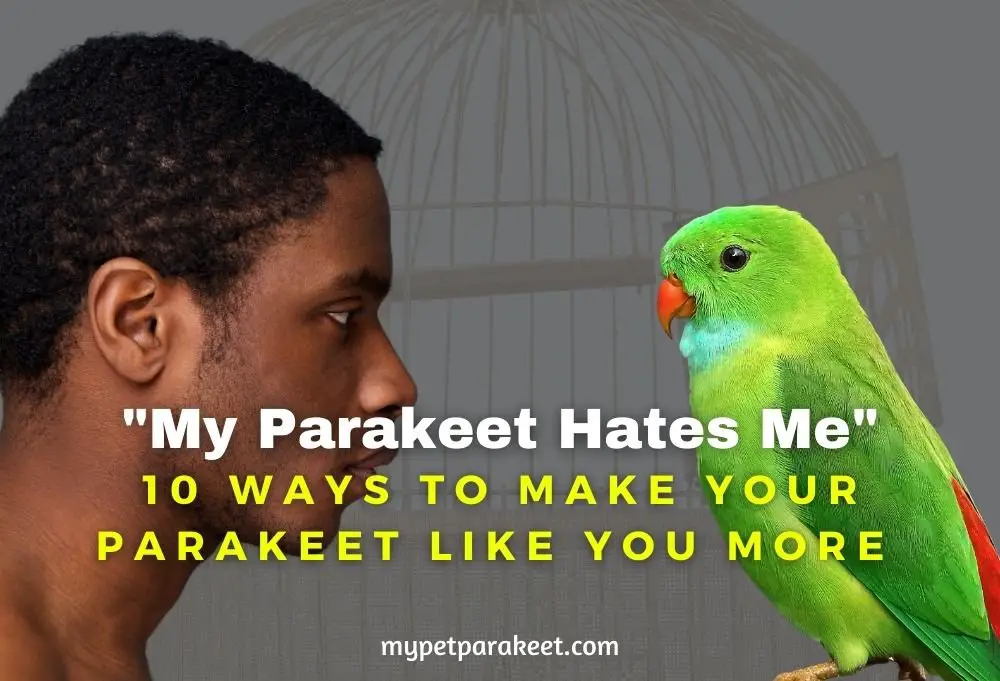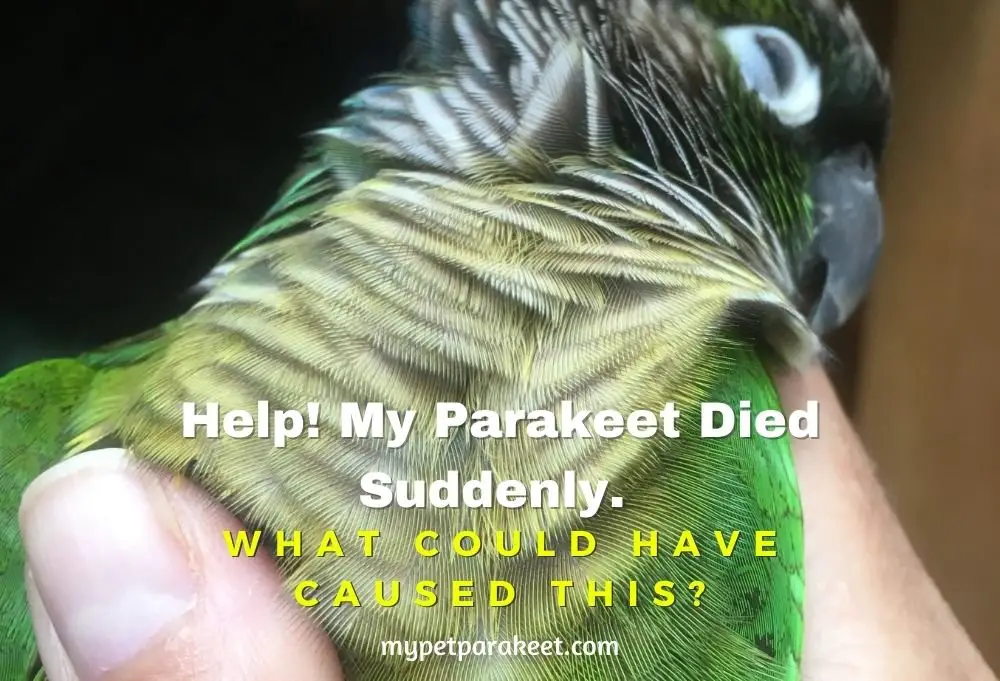Many pet owners are unsure of if they should clip their parakeet's wings. There are a lot of benefits that come with clipping and also some disadvantages.
In this article, we will explore both the good things about clipping your parakeet's wings and the bad things. We will also cover the most common questions, concerns, and issues that might arise.
- What Is Parakeet Wing Clipping?
- Wing Clipping Your Parakeet – Should You?
- How Does Your Parakeet Feel About It?
- Weighing Out The Options
- Choosing To Clip Your Parakeets Wings
- Choosing Not To Clip Your Parakeets Wings
- How To Clip Your Parakeets Wings At Home (Yourself)
- How can you make sure to avoid injury when clipping your pet bird's wing feathers?
- Where Can I Learn More About Wing Clipping?
- Conclusion
- Don't Forget Your Pet Parakeet Must-Haves!
What Is Parakeet Wing Clipping?
Traditionally, bird owners have clipped their pet birds' primary wing feathers to prevent them from flying too high or far. This is done because it can be dangerous for a domesticated bird to fly away.
Does Wing Clipping Hurt The Bird?
No. Wing clipping does not hurt the bird. Wing clipping is no different from a human getting a haircut! There are no nerve endings in the feathers, so parakeets don't feel any pain.
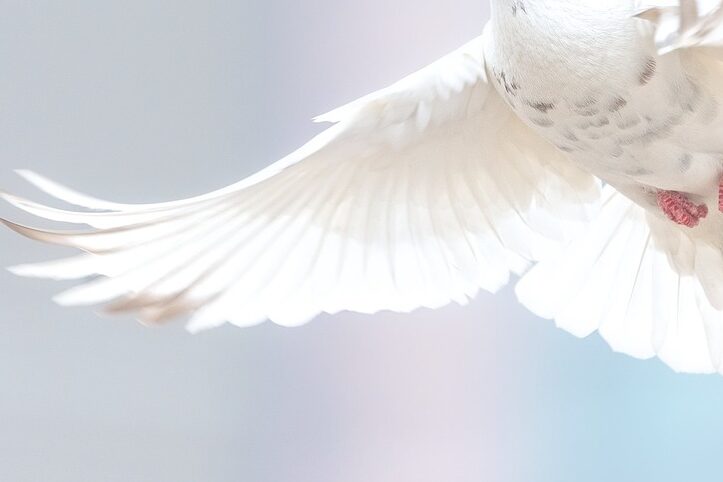
However, whether you are Goldielocks or Doctor Evil, your mobility is not affected by your hairstyle. With wing clipping, your parakeet's mobility will be impaired.
Parakeets are very agile flyers. However, a clipped parakeet can still quickly take off and be lost forever in an instant. This often scares owners, who then decide to clip the secondary flight feathers as well as primary flight feathers.
Wing Clipping Your Parakeet – Should You?
The two biggest concerns when it comes to wing clipping is the birds need for its feathers and the lack of exercise from the inability to fly. It can be argued that while wing clipping does not affect insulation, it does affect the amount of exercise the bird would get, after all, birds are designed to fly!
There are valid points to be made on either side of this controversial issue.
Ultimately clipping your parakeet's wings is a personal decision, but these pros and cons should help you with this decision.
Let's break down the pros and cons of parakeet wing clipping:
Pros
(Reasons Why You Should Clip Your Parakeet's Wings)
- Your flighted pet parakeet would find your home to be a very dangerous place. Household features such as windows and fans are potential hazards to a parakeet.
- Clipped parakeets are less likely to go missing as they cannot fly away through an open window or door.
- Clipped parakeets are less likely to find dangerous places in your home, toxic plants, or fly into open toilets.
- A clipped parakeet is easier to tame and train as it cannot easily retreat by flying away.
- If your clipped parakeet somehow managed to escape, it is still more likely to stay in the general area of your home.
Cons
(Reasons Why You Should NOT Clip Your Parakeet's Wings)
- It is cruel to clip a parakeet's wings. After all, birds are designed to fly.
- As a prey animal, a parakeet's wings are its best chance at survival. Clipping its wings take away the only advantage it has when it is in danger.
- Clipping your parakeet's wings reduces the amount of exercise it gets every day. This can lead to a decline in its health.
- If you do not do a good job of the wing clipping, you could cause your parakeet permanent damage. Not to mention, your parakeet could lose its balance and have a dangerous fall.
- Many owners claim that their clipped parakeet is less friendly and not as interesting as a flighted one.
- The feathers of the clipped parakeet are prone to dry out, break and irritate the skin beneath them due to their inability to preen themselves.
How Does Your Parakeet Feel About It?
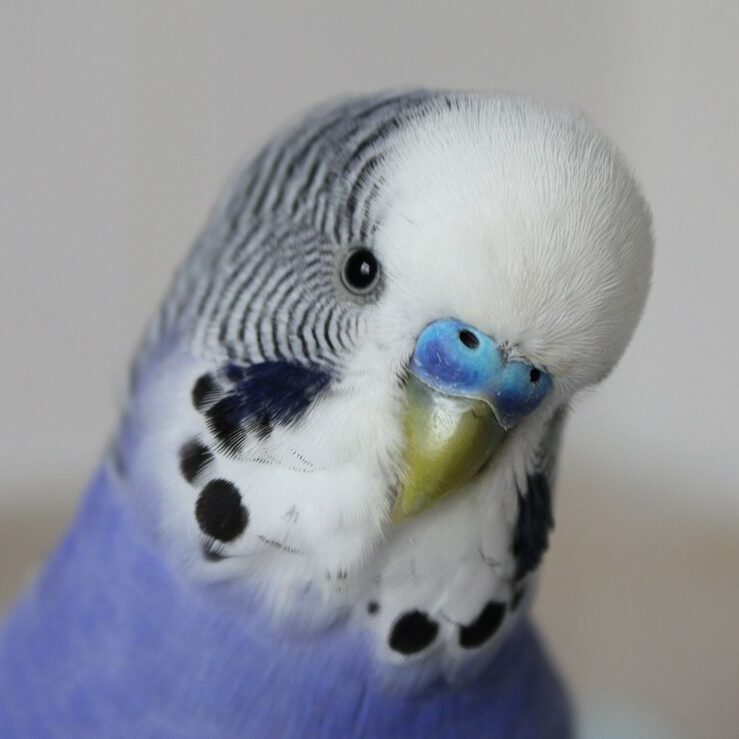
Throughout Europe, the idea of wing clipping is less prevalent today, however, in America, it is still widely used.
Behind all the debates, questions and concerns lie one question that no one thinks about:
What does your parakeet think of having its wings clipped?
Flighted birds fly to wherever they want and do whatever they please. They can protect themselves from predators by flying away, but in a cage without any way out of it, this becomes impossible.
Clipped wings make the bird feel like it's missing something important about being a bird, so it must change itself to fit who he or she is now instead of how nature intended them to be.
Clipping a bird's wings takes away an integral part of its being- it is meant to be as free and independent as possible.
A parakeet's inability to fly can have severe adverse effects on its mental state. The bird may show a host of negative behaviors, including aggression, depression, and fearfulness.
Most responsible breeders advocate that all baby birds should at least have enough time for some practice flying before they go into new homes where they will no longer get this opportunity.
Weighing Out The Options
Of course, wing clipping is a sensitive subject and there are people on both sides of the argument.
No matter how you feel about it, as owners, we need to respect each other's opinions and decisions.
I like the idea of bird-proofing the home so that flight does not present a risk to the parakeet and this is what I opt for.
However, I didn't write this post to tell you whether you should or shouldn't, so my personal beliefs do not matter. All that matters is that you have all the information you need to make the best decision for your household.
Below you will find some considerations if you are still undecided.
- Keeping your bird clipped for a short time frame. For example, during summer time. As wings grow out during a molt which is generally once a year. During summer time, you are more likely to have your windows open so you could have your parakeet clipped just for this season.
- Clip only a few flight feathers. Some owners will decide to clip only the first four flight feathers. A parakeet will still have enough lift to fly a couple of feet off the ground. However, it may not be able to take flight.
- Buying or building an aviary. It doesn't need to be humongous , but something that can allow your parakeet to exercise and have some fun.
Choosing To Clip Your Parakeets Wings
If you can't keep your parakeet in an aviary, then you might wish to clip its flight feathers. If it flies freely around your home, it might fly out of a window and/or have and have a fatal accident. Even the best birdkeepers cannot predict accidents when they happen. So in this case, opt to clip its wings before letting it out of the cage.
Recommendations For Keeping A Clipped Parakeet:
- Ensure that a professional bird groomer clips your parakeet. If parakeet wing clipping is done wrong, this can lead to plucking. This is often the case as the result is skin irritation.
- If you are clipping the wings yourself, make sure that you are doing it properly and double-check the methods and tools before you begin
- Always ensure you have a parakeet first aid kit to hand, in the event of an emergency.
- Only clip a few flight feathers to begin with and monitor how your parakeet reacts. If it is still flying around a lot, you will need to clip more feathers.
- Don't forget to keep some feathers so your bird can still catch itself if it falls (cutting its feathers will not stop it from attempting to fly!)
- Clipping only needs to be done one or two times per year; after molting.
- As you are taking away its primary gym equipment, you will need to ensure your parakeet is still getting enough exercise.
- Ensure your bird has enough perches and toys to play with, being clipped must get a little boring!
Choosing Not To Clip Your Parakeets Wings
If you decide against clipping your bird's wings, here are some tips for keeping your bird safe.
- Monitor your bird at all times.
- Do not go outside with your bird perched on your shoulder and no harness or carrier.
- If you are walking around the house with your flighted bird perched on your hand. Use your thumb to hold its toes just in case it tries to fly off into a room that is not bird-ready.
- Tame and train your bird as soon as possible, including commands such as flying over to you when you call or whistle at them.
How To Clip Your Parakeets Wings At Home (Yourself)
Before we begin, if you have not already, I would recommend you have a professional clip your parakeet's wings in your presence the first time. This will allow you to observe how it is done and ask any questions you may have.
The following will aid you in correctly clipping your parakeet's wings:
Hold Your Bird The Correct Way: Toweling
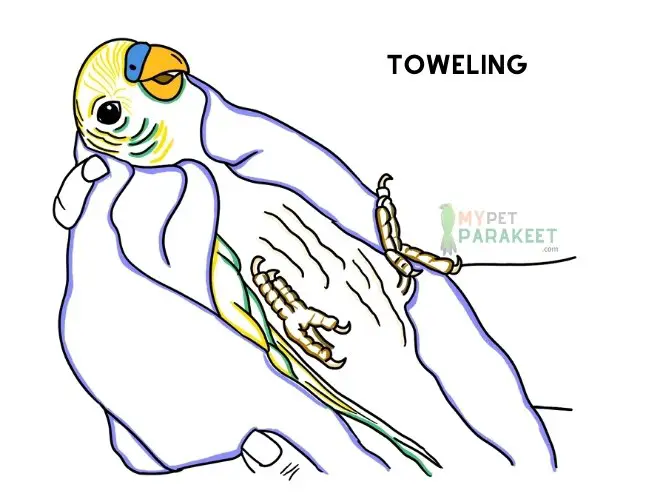
Toweling is a method to hold the parakeet in place, safely, as you clip its wings.
It is important to know how to safely hold a bird. They have fragile bones and breathe differently than we do, so they can get hurt easily if you don't handle them the right way!
The best way is around their neck with your hand on top of theirs in order to let them breathe freely while keeping them safe from harm.
With one hand, grasp the bird around her neck and back. With your other hand, brace against the bottom of its jaw to keep it from flapping too much while you collar them with a thin towel.
Flight Feather Clipping
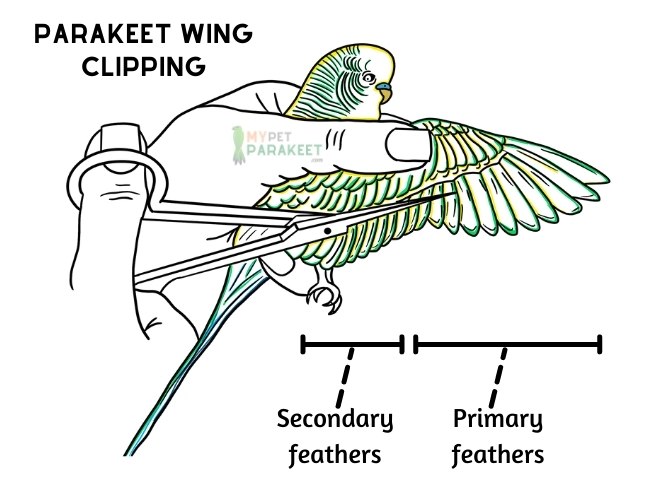
- Gently extend the first wing.
- Clip 4-6 of the first primary feathers.
- Start at the base of the wing, cut down to the tip, and make sure you do not clip any more feathers than you have to.
- It is important not to remove too many flight feathers in one go but rather one by one.
- Ensure the scissors are the correct scissors for wing clipping and that they are sharp.
- Be sure to clip both wings. Otherwise, your parakeet will become distraught.
- When you cut the feathers, they should be left blunt, as sharp cuts will result in irritation which leads to itching and plucking (and a very unhappy bird.)
How can you make sure to avoid injury when clipping your pet bird's wing feathers?
It's important to calmly talk to your bird while clipping. This helps provide reassurance that this is not something they need to be scared of, and will hopefully help reduce their fear response.
Where Can I Learn More About Wing Clipping?
The following Youtube videos will be helpful for learning the most popular methods of clipping your parakeet's wing. They are also very useful for seeing how to clip smaller birds such as finches and canaries before you attempt larger ones like cockatiels, cockatoos, and macaws.
Conclusion
There are a lot of ways to go about clipping your bird's wings, and the decision is up to you. We recommend having a professional clip your parakeet's wings in front of you for the first time so that everyone can see how it is done correctly.
If not, we hope these tips will help make sure everything goes smoothly when at home! There are many benefits to wing clipping (less chance they'll get hurt or lost) but also some drawbacks (they won't be able to fly around, be free and, get exercise).
It really comes down to what would work best for both parties involved; if I were deciding whether or not my pet should have its wings clipped, I'd consider all factors before making any decisions.
Don't forget to visit us on Youtube.
Pin us on Pinterest and,
Leave a comment if you found this information useful.





